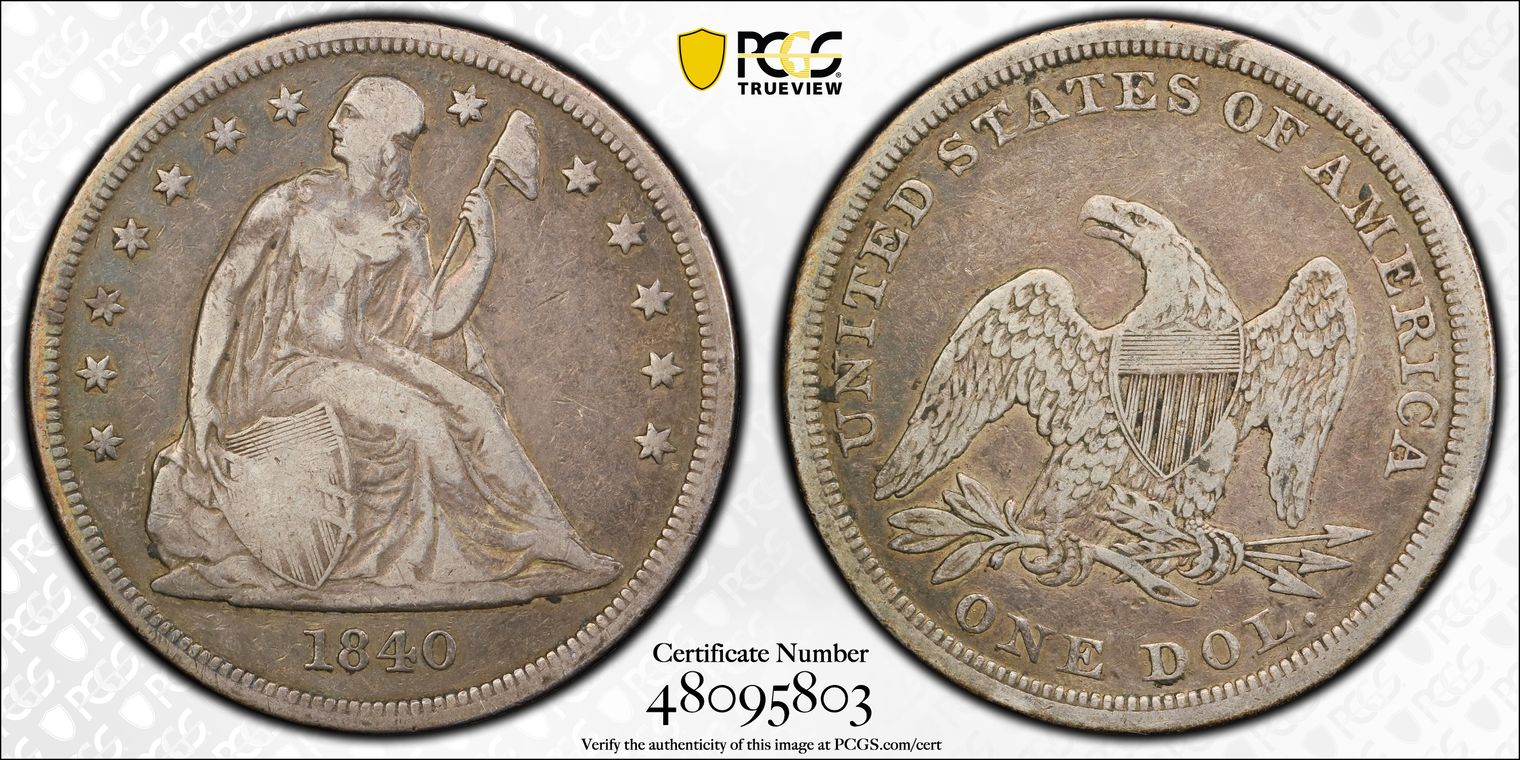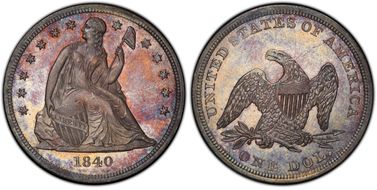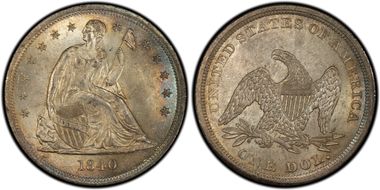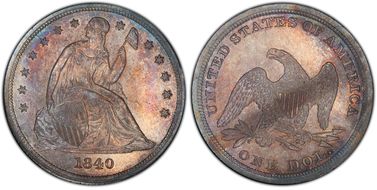1840 $1 F15 认证号48095803, PCGS号6926
拥有者评论
专家评论
Ron Guth
Traditionally and in general, collectors save first-year type coins because of the novelty of the new designs. Thus many first-year type coins appear in unusually high quantities and in above-average grades because they we set aside and preserved. Such was not the case with the 1840 Seated Liberty Dollar. The explanation could be simple: perhaps collectors could not afford to set aside quantities of high-value dollar coins or the design may have been too similar to that of the Gobrecht Dollars issued from 1836-1839. Whatever the reason, collectors now face a challenge finding nice examples of this date. The 1840 Silver Dollar ranks in the rarest third of all dates in the series. Nonetheless, collectors should have no problem finding a circulated example of this date, but Mint State eamples may be hard to locate.
As of September 2011, PCGS had certified 276 1840 Silver Dollars in all grades, including 28 Mint State examples. Virtually all Mint State 1840 Silver Dollars fall into the MS-62 and MS-63 grade levels, with three MS-64 examples being the finest that PCGS had certified.
Q. David Bowers
The following narrative, with minor editing, is from my "Silver Dollars & Trade Dollars of the United States: A Complete Encyclopedia" (Wolfeboro, NH: Bowers and Merena Galleries, Inc., 1993).Coinage Context
First quantity coinage in many years: Although the Mint released for circulation some 1,900 Gobrecht dollars dated 1836 and 1839, the last large quantity mintage of this denomination prior to 1840 was when dollars dated 1802 and 1803 were made in 1804.
Not much need for dollars: After August 1, 1834, when the authorized weight was reduced, gold coins were made in large quantities and stayed in the channels of commerce. By 1840, numerous $2.50 and $5 gold coins were in circulation and were in the reserve accounts of banks, reducing the need for silver dollars. (Carothers discusses this in Fractional Money, p. 99.) There was a great demand, however, for lower denomination silver coins, and unprecedented quantities of half dimes, dimes, and quarter dollars spewed forth from coining presses in Philadelphia and, to a lesser extent, New Orleans. Carothers notes that "more of these pieces were coined in the four years after 1834 than in the previous history of the Mint."
Further, by 1840 the general public had become quite used to Capped Bust half dollars (minted 1807-1836) and the half dollars of the dates immediately preceding and following, made in large quantities, and there was no widespread call for new coins of the higher dollar denomination. What demand there might have been for additional larger silver coins was diminished with the advent of large amounts of new gold coins after August 1, 1834, as noted.
Silver bullion scarce: Even if silver dollars had been wanted, there was no significant supply of native silver on hand from which to coin them. In 1840 the United States was producing from its own mines a yearly average of only $25,000 worth of the metal, only a fraction of what was needed to make other silver coins (half dimes to half dollars).
Silver for coinage purposes had to be imported or made from melted-down Spanish-American and other foreign coins in American circulation. Ironically, the legal tender "silver dollars" in commerce were more often than not apt to be products of one of the numerous mints of Mexico, a country which, unlike the United States, was busy mining more silver than it knew what to do with.
Silver dollars for silver bullions (Information under the "Silver dollars for silver bullion" heading is from R.W.Julian). From 1840 to 1852, dollars were coined essentially on demand from the public. Those who wanted dollars brought the necessary bullion to the mint of their choice (Philadelphia or New Orleans; the latter mint making its first dollars in 1846) and received the coins. It worked the same way for lower denominations.
After January 1837 there was a bullion fund established for each mint as was necessary, so that coins could be struck in advance and the deposit paid off more quickly. (Later, after the opening of the Carson City Mint in 1870, that facility did not have a bullion fund for silver dollars and gold coins, and depositors of bullion had to wait for payment.) How many silver dollars were struck in advance prior to 1852 cannot now be determined unless a researcher were to spend considerable time at the Archives examining the accounts. It is believed that the silver dollar did not have much advance coinage.
The original intention of the silver dollar, as explained by Director Robert Maskell Patterson in the 1830s, was to alleviate the large coinages of half dollars. Many of these half dollars were meant for backing of the paper money issued by various private banks and other entities, such as the semi-official state banks. The dollar coinages of 1840-1852 reflect the demands by private individuals and institutions for such coinage, and to get it they had to deposit silver bullion. (Individual specimens and Proof pieces were available on a limited basis to the public.)
Silver dollars circulated: For most years during the 1840s, a silver dollar was worth just slightly over face value in terms of gold, not enough of a premium to warrant melting into bullion. Thus, large numbers of dollars circulated. While the new Liberty Seated dollars were produced and used domestically, as time went on, and especially after the Orient trade increased out of San Francisco after 1849-1850, many such dollars were shipped overseas where they were melted. During the 1840s, much more value in silver was coined in half dollars than in silver dollars. Taking the year 1840, silver dollars amounted to 61,005 pieces, while half dollars came to 2,290,108 coins with a face value of $1,145,054, or 19 times greater than the value of silver dollars minted during the same 12-month period.
While there is no doubt that the Liberty Seated dollar did its duty in American commerce during the 1840s, all during the Liberty Seated dollar era half dollars were the coins of choice in the United States. As noted earlier, the point became moot after the spring of 1853, when Mint Director James Ross Snowden halted the payment of silver dollars at par. After that time, Liberty Seated dollars ceased to circulate, as their silver value was higher than their face value.
Numismatic Information
Circulated grades: The 1840 Liberty Seated dollar has always been available in circulated grades, with typical specimens grading VF or so. However, in 1859 Dr. Montroville W. Dickeson called the 1840 "scarce," and this was less than two decades after its mintage! The explanation is that while during the decade of their issue in the 1840s dollars of this date were plentiful enough, after the price rise of silver in the spring of 1853, dollars of all earlier dates were withdrawn from circulation, and, to a degree, all became "scarce."
As with all Liberty Seated dollars, the prominent relief of the shield causes the word LIBERTY to wear away much faster than on lower denominations in the Liberty Seated series, particularly the half dime and dime. These latter denominations can be worn considerably and still have LIBERTY showing, whereas on silver dollars the word begins to disappear after only slight wear.
Silver dollars dated 1840 have always been in strong demand by collectors as the first year of the design type. Most dollars of this era have bold, broad rims, making them very attractive but, at the same time, susceptible to bruises.
Mint State grades: Although this was the first year of issue of the Liberty Seated obverse in combination with the perched eagle reverse, there seems to have been little or no public interest in saving them, perhaps because during the "Hard Times" era (1837-1844) most people could not afford to squirrel them away. This is a major exception to the "first year of issue" theme which induced collectors and the general public to hoard such diverse issues in other series as the 1909 V.D.B. Lincoln cents, 1883 no CENTS Liberty nickels, 1913 Buffalo nickels, 1916 "Mercury" dimes, 1932 Washington quarters, etc.
No record exists of any contemporary numismatic interest in Mint State specimens, although probably fewer than a dozen numismatists at the time (of the likes of William Sumner Appleton, Joseph J. Mickley, et al.) and the Mint Cabinet (begun at the Mint in 1838) acquired Proof strikings. These probably were purchased for face value.
In true Mint State the 1840 is exceedingly rare, and very few have a claim to MS-63 or higher grade. In 1982, Bruce Amspacher, an especially astute observer of the numismatic scene, stated that he knew of only three pieces that could be called MS-65, a grade that today would be equal to MS-63 or SO. (Article, "Liberty Seated Dollars," in the Monthly Summary, Coin Dealer Newsletter, July-August, 1982.) Chris Napolitano reported handling two MS-63 coins ("average for the grade") and one MS-62 piece ("white and frosty") over a long period of years. (Letter to the author, June 26,1992 )
Circulation strikes:
1-3. Normal Date: Breen-5425. At least three obverse dies were used to make circulation strikes. The details of these have not been delineated in numismatic literature. The reverse of the American Numismatic Society specimen has a die crack from the rim to the right edge of L in DOL. to the bottom arrowhead.
Circulation strike mintage: 61,005; Delivery figures by day: July 31: 12,500; November 30: 41,000; December 31: 7,505.
Estimated quantity melted: Unknown
Characteristics of striking: Usually quite well struck with sharp stars and prominent, broad rims.
Known hoards of Mint State coins: None
Commentary
This, the first year of the Liberty Seated dollar, was not saved in quantity at the time of issue. Mint State coins are very rare.
稀有性和存量估计 了解更多
| 所有评级 | 2500 |
| 60或以上 | 50 |
| 65或以上 | 0 |
| 所有评级 | R-4.5 |
| 60或以上 | R-8.5 |
| 65或以上 | R-10.1 |
| 所有评级 | 22 / 30 TIE |
| 60或以上 | 11 / 30 TIE |
| 65或以上 | 1 / 30 |
| 所有评级 | 33 / 45 TIE |
| 60或以上 | 17 / 45 TIE |
| 65或以上 | 1 / 45 |























